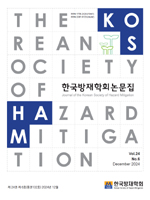최근 기후변화로 인하여 물부족 현상이 발생함에 따라 수질에도 큰 영향을 주고 있다. 따라서, 본 연구에서는 금강의 지류수질에 가장 큰 영향을 주는 대청댐의 용수공급능력을 재평가하였고, 이에 따른 추가용수공급 가능량을 산정하였다. 저수지 모의운영은 저류방정식을 적용하여 1983년부터 2023년까지 약 40년 기간에 대하여 저수지 모의 운영을 실시하였다. 본 연구에서 용수공급능력의 평가기준인 이수안전도는 기본계획공급량(52.3 m³/s) 기준 신뢰도 96.3%, 2023년 계약공급량(40.5 m³/s) 기준신뢰도 98.7%의 5일(반순)단위 평가를 기준으로 설정하였다. 기본계획공급량 기준 5일단위 및 이수안전도 96.3%를 만족하는 범위에서 최대 0.11 m³/s 추가공급이 가능했고, 2023년 계약공급량 기준 5일단위 및 이수안전도 98.7%를 만족하는 범위에서 최대 0.23 m³/s 추가공급이 가능한 것으로 분석되었다. 다만, 이수안전도의 경우 최저수위를 기준으로 평가됨에 따라 용수공급조정기준 중 관심수위 이하로 떨어지지 않는 범위에서 추가 공급가능율을 재산정하여 평가하였다. 평가 결과 이수안전도를 만족하지만 용수공급조정기준의 관심수위 이하로 떨어지면서 공급가능률이 대부분 저하되는 것으로 평가되었다.
Recent climate change has significantly affected water quality and led to water shortages. Accordingly, this study re-evaluated the water supply capacity of the Daecheong Dam and calculated the additional water supply available to determine the feasibility of meeting the target water quality for the Mihogang River. The Mihogang River is directly influenced by the Daecheong Dam, which is situated in the middle section of the Geumgang River. A reservoir simulation was conducted over approximately 40 years (from 1983 to 2023) using the storage equation. The results of an analysis demonstrated that an additional supply of up to 0.11 m³/s could be provided while maintaining the planned supply amount over a five-day period, thus ensuring a water utilization reliability of 96.3%. In addition, an additional supply of up to 0.23 m³/s was found to be feasible within the supply range stipulated in the 2023 contract for a five-day period, thus ensuring a reliability of 98.7%. However, because the reliability of water utilization is typically evaluated based on the lowest water level, our study recalculated and reassessed the potential for additional supply to ensure that the water level complied with water supply adjustment standards. The evaluation results showed that although the water utilization reliability was met, the supply availability rate generally decreased and fell below the level of concern specified in the water supply adjustment standards.
1. 서 론
2. 연구대상유역
3. 용수공급능력 평가 방법
4. 댐 용수공급 조정기준
5. 이수안전도 평가 및 추가공급가능량 검토
6. 결 론
감사의 글
References
